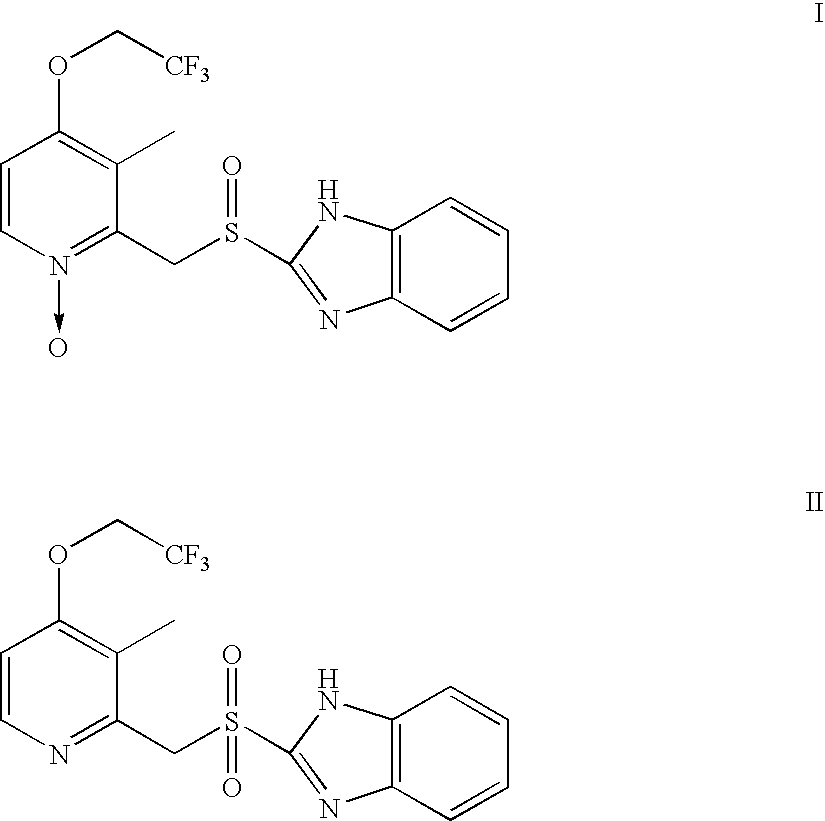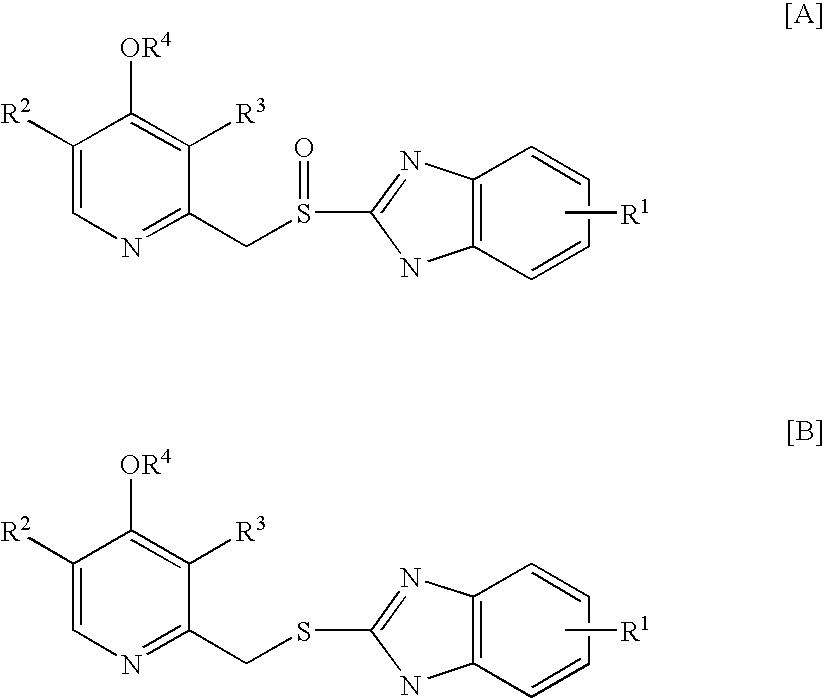Method for preparing 2- (2-pyridinylmethylsulfinyl) benzimidazoles
a technology of benzimidazoles and pyridinylmethylsulfinyl, which is applied in the field of preparation of antiulcer agents, can solve the problems of method difficulty in quality control, method difficulty in mass production, and high cost of mcpba, and achieves mild reaction conditions and less cost
- Summary
- Abstract
- Description
- Claims
- Application Information
AI Technical Summary
Benefits of technology
Problems solved by technology
Method used
Image
Examples
example 1
[0023]2 g of 2-[[(3,5-dimethyl-4-methoxy-2-pyridinyl)methyl]thio]-5-methoxy-1H-benzimidazole was suspended in 36 ml of methanol at room temperature, to which 1.88 g of 45% NaOH in 14 ml water was added while stirring. 0.09 g of Na2WO4·2H2O oxidation catalyst was dissolved in 0.74 g H2O2 (50% aqueous solution), and further diluted with 10 ml. of water. The oxidant / catalyst solution was added to the reactant / base solution dropwise so that the addition was completed in about 30 minutes while stirring at room temperature. The reaction was continued for additional 10 minutes while stirring. 10 ml of 10% Na2S2O3 aqueous solution was then added, and the resulting mixture was subjected to a reduced pressure to remove methanol therefrom. Finally, a precipitate was formed after adding a diluted acetic acid aqueous solution to a pH value of about 8, which was filtered, water washed, and dried in vacuo to obtain Omeprazole with a yield of about 88% (LC purity>95%).
example 2
[0024]The procedures in Example 1 were repeated except that the 1.88 g of 45% NaOH was replaced by 1.93 g of Na2CO3. Omeprazole yield: 91% (LC purity>95%).
example 3
[0025]2 g of 2-[[[3-methyl-4-(2,2,2-trifluoroethoxy)-2-pyridinyl]methyl]thio]-1H-benzimidazole was suspended in 36 ml of methanol at room temperature, to which 1.76 g of 45% NaOH in 14 ml water was added while stirring. 0.09 g of Na2WO4·2H2O oxidation catalyst was dissolved in 0.77 g H2O2 (50% aqueous solution), and further diluted with 10 ml of water. The oxidant / catalyst solution was added to the reactant / base solution dropwise so that the addition was completed in about 30 minutes while stirring at room temperature. The reaction was continued for additional 10 minutes while stirring. 10 ml of 10% Na2S2O3 aqueous solution was then added, and the resulting mixture was subjected to a reduced pressure to remove methanol therefrom. Finally, a precipitate was formed after adding a diluted acetic acid aqueous solution to a pH value of about 8, which was filtered, water washed, and dried in vacuo to obtain Lansoprazole with a yield of about 90.8% (LC purity>95%).
PUM
| Property | Measurement | Unit |
|---|---|---|
| temperature | aaaaa | aaaaa |
| temperature | aaaaa | aaaaa |
| temperature | aaaaa | aaaaa |
Abstract
Description
Claims
Application Information
 Login to View More
Login to View More - R&D
- Intellectual Property
- Life Sciences
- Materials
- Tech Scout
- Unparalleled Data Quality
- Higher Quality Content
- 60% Fewer Hallucinations
Browse by: Latest US Patents, China's latest patents, Technical Efficacy Thesaurus, Application Domain, Technology Topic, Popular Technical Reports.
© 2025 PatSnap. All rights reserved.Legal|Privacy policy|Modern Slavery Act Transparency Statement|Sitemap|About US| Contact US: help@patsnap.com



